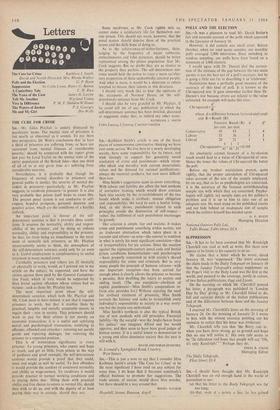POLLS AND THE ELECTION
SIR,—It was a pleasure to read Mr. David Butler's fair and accurate account of the polls which appeared in the Spectator of January 10.
However, it did contain one small error. Before October, when we used quota samples, our monthly polls averaged 2,000 interviews. Since switching to random sampling, our polls have been based on a minimum of 3,000 electors. would agree with Dr. Durant that the correct- ness of the estimate of the gap between the two main parties is not the best test of a accuracy, but he is going a little too far in describing it as 'irrelevant.'
Statisticians have a perfectly good measure of the accuracy of this kind of poll. It is known as the Chi-squared test. It goes somewhat farther than Dr. Durant's test because errors are related to the value • estimated. An example will make this clear.
d' Chi-squared =— R where d =difference between forecast and result and R=Result (R)
Forecast Result (R) per cent per cent d d' Conservative 45 43
4 Labour 35 36
1 Liberal
20 ' 21
1 1 4 1 1
Chi-squared -= 43+ 3-6+ 21=0.168
An absolutely correct forecast of a by-election result would lead to a value of Chi-squared of zero. Hence the lower the values of Chi-squared the better the poll.
Before my brother statisticians protest, quite rightly, that the proper calculation of Chi-squared takes account of the size of the sample employed, let me say, that as far as psephologists are concerned, it is the accuracy of the forecast notwithstanding sample size with which they are concerned. Psepho- logists will rightly say sample sizes are the pollster's problem and it is up to him to take one of an adequate size. He must stand on the published results and not hide behind an inadequate size of sample which the pollster himself has decided upon.
Tallis House, Tallis Street, EC4






































 Previous page
Previous page